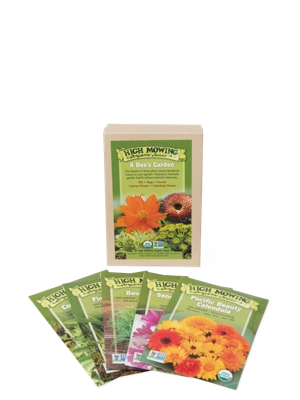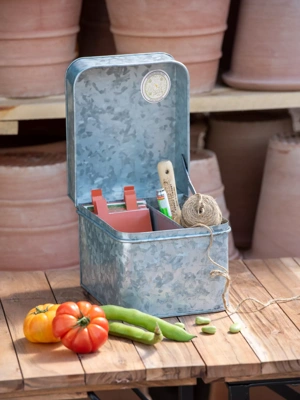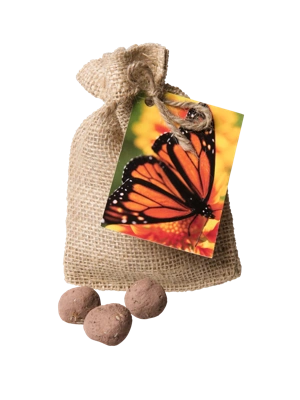Gardening with Wildflowers and Native Plants
 Orange milkweed (Asclepias tuberosa ) is native to eastern North America. Photos: Suzanne DeJohn.
Orange milkweed (Asclepias tuberosa ) is native to eastern North America. Photos: Suzanne DeJohn.In This Article
 Cranesbill (Geranium maculatum) attracts butterflies and other pollinators.
Cranesbill (Geranium maculatum) attracts butterflies and other pollinators.In a world dominated by red geraniums, pink begonias and yellow marigolds, wildflowers possess a simple grace and elegance. Most any garden or landscape is enhanced by their presence.
Wildflowers have merit not only for their ornamental qualities, but for their toughness and ease of maintenance as well. Once established in their preferred habitat, they usually require very little attention, providing you with years of carefree beauty. Native plants also play an additional valuable role in preserving biodiversity and ecological balance. Since these plants evolved alongside native insects, birds and other creatures, they're often an important source of food and shelter.
Wild Doesn't Always Mean Native
Not all plants that grow wild in North America are necessarily natives. Many that we now consider wildflowers have been introduced to the wild, either intentionally or by accident. Some of these garden plants escaped from cultivation and have become widely naturalized over the years, surviving and spreading in the wild. In fact, a few, such as Queen Anne's lace (Daucus carota) and purple loosestrife (Lythrum salicaria) have adapted so successfully that they are now considered weeds, albeit pretty ones.
 California poppy (Eschscholzia californica) brightens hillsides on the west coast.
California poppy (Eschscholzia californica) brightens hillsides on the west coast.Books on wildflowers often feature maps of North America, with shaded regions indicating where a particular wildflower grows as a native species. This is good to keep in mind, but unless you're a purist, the fact that a given plant isn't native to your region doesn't necessarily mean that you can't grow it successfully.
For instance, plenty of gardeners outside of California grow the California poppy (Eschscholzia californica) — usually as a hardy annual. In its native range and preferred growing conditions (Zone 8 to 10, well-drained soil, full sun), California poppy self-sows vigorously and is considered a short-lived perennial. In other locations, it performs like an annual and often needs replanting each year. Many species exhibit this kind of "home court advantage;" they are adaptable enough to grow well in other regions of the country, but tend to perform best in the climate and growing conditions found in their native range.
So when you are considering which wildflowers to grow in your garden, remember that species that are native (or already well-adapted) to your part of the country will usually have an advantage over other species. Topography, soils and other factors all come into play, but generally speaking, it is easier to create a home for wildflowers that have already proven to be well-suited to your region.
 Foamflower (Tiarella cordifolia) thrives in part shade to full shade.
Foamflower (Tiarella cordifolia) thrives in part shade to full shade.Evaluating Your Site: Sunny or Shady?
The physical characteristics of your garden or landscape will determine, to a great extent, the specific kinds of wildflowers or native plants that you can grow. Fortunately, there are wildflowers suited to practically every ecological niche, from the bog-loving marsh marigold (Caltha palustris) to the desert marigold (Baileya multiradiata).
Before deciding what types of wildflowers to grow, take a walk around your property and observe the different kinds of sites you have. Try to gauge the sunlight on particular locations: does a spot receive full sun for many hours a day, is it shaded part of the time, or does the sun filter down through leaves to create a dappled light shade?
If you're observing your yard during late fall or early spring, when trees and shrubs are leafless, picture how much shade wildflowers will get in the summer if planted in their vicinity. Also consider the soils. Are areas dry and parched, or moist and boggy? Are sites protected from the wind or exposed?
The amount and quality of sunlight received each day can be crucial for native plants. Wildflowers common to prairies and large, open meadows normally grow in full sun and will do best when they receive half a day or more of direct sunlight. Plants classified as savanna or open woodland species prefer growing in partial shade, with sunlight reaching the ground between trees. Woodland plants grow best in partial to full shade, beneath a more or less solid canopy of trees.
Some flowers that grow in shady woods manage to get the sunlight they need by flowering early in the spring. For instance, trillium and hepatica love growing in humus-rich woodland soil; they bloom quite early, while the spring sun shines through the bare trees. Once the weather warms up and the trees leaf out, these plants enjoy growing in filtered shade. Since they can't just pick up their roots and move, they have arranged their flowering schedule accordingly.
Soil and Water Conditions
Other major factors to consider when looking over your property are the types of soil you have, their acidity or alkalinity as measured by soil pH, and the amount of water they retain at various times of the year.
 Black-eyed Susans (Rudbeckia spp.) brighten a border. Their long season of bloom is a boon to pollinators.
Black-eyed Susans (Rudbeckia spp.) brighten a border. Their long season of bloom is a boon to pollinators.Many wildflowers will tolerate drought conditions or relatively poor soils. Yet even these tough customers, such as black-eyed Susan (Rudbeckia hirta), will grow taller and more vigorously if planted in richer soil. In fact, you might decide to plant black-eyed Susan in an area with relatively poor soil, simply to curb its enthusiastic nature.
Finally, when reading up on wildflowers and the conditions they like, remember that the same plant often prefers different growing conditions in different regions of the country. For instance, many species that grow well in full sun in the North perform best in partial shade when planted in areas that have long, hot summers.
Sources of Native Plants
Collecting native plants from the wild is at best unethical and often illegal in the case of rare or threatened species like lady's-slippers and pitcher plants. What's more, wild plants are often uniquely adapted to their growing conditions and they frequently do not survive a move from their natural habitat to the confines of the home garden.
In other words, you should not dig up a plant in the wild for your garden. Fortunately, there are many reputable nurseries that propagate wildflower plants from seed. Mail-order nurseries typically ship these plants when they are dormant, usually in early spring or fall. Either season is fine for transplanting most wildflowers, although certain species adapt better to fall planting, such as birdsfoot violet (Viola pedata) and violet wood sorrel (Oxalis violacea).
Collecting seeds of wildflowers is appropriate, so long as you harvest seeds judiciously, taking only a small sample so the existing plant colonies will be able to reproduce themselves. Today, wildflower seeds are quite widely available from commercial seed suppliers, so you're frequently better off ordering from them. Growing plants from seed is certainly more economical than buying mature plants. The main disadvantage is that many native plants require a long time to mature or even to germinate from seed. Also, the seeds of many species need pretreatment — planting the seeds in a pot and then refrigerating them for several months until the seeds are fooled into believing that it's time to break dormancy and germinate.
Unless you are patient and have some experienced growing plants from seed, it's probably best to start your wildflower garden by purchasing plants from a reputable nursery. The main exception is growing a wildflower lawn or meadow, in which case you can sow mixed seeds directly on top of the ground in either the fall or spring.
 Bergamot (Monarda fistulosa), also known as bee balm, is a magnet for hummingbirds, butterflies, and other pollinators, like this hoverfly.
Bergamot (Monarda fistulosa), also known as bee balm, is a magnet for hummingbirds, butterflies, and other pollinators, like this hoverfly.Aggressive Plants
As plants that exist happily in the wild without human care, native plants tend to be quite efficient at reproducing themselves through seed dispersal and other means. In most situations, this is a desirable trait. But some native plants take this exuberance to extremes, so it pays to do some research and try to avoid creating problems down the line. Since a plant that's well mannered in one region can act like a thug in another, it's best to get this information from your state Extension Service Office or Natural Resources Department.
Integrating Natives Into Your Gardens and Landscape
Wildflowers and native plants don't have to be relegated to areas outside your flower garden. While it would be a mistake to introduce aggressive plants into a formal bed or border, many other wildflowers are well-mannered and perfectly at home in the garden proper. When you're including these plants in a formal garden, try to select ones that will not only complement the rest of the bed in terms of height, bloom time and color, but that will also be compatible partners in their growth habit. The informal habit of a 4 ft. tall New England aster is lovely in a hedgerow or along a fence, but might be all wrong in a formal bed with peonies and clipped boxwood.
Creating a little garden of wildflowers, set off unto itself, can be a wonderful way to display wildflowers. This also gives you a chance to get to know the habits and ornamental qualities of various native plants before adding them to your other beds and borders.
Rock gardens are a perfect environment for native alpine plants and plants that are native to the arid West or Southwest. All need plenty of sun, good air circulation, and sharply drained soil. Two good examples are the spring-blooming pasqueflower (Anemone patens), with its pretty pastel blue blossoms and fuzzy white seedheads, and the poppy mallow (Callirhoe triangulata), a low, spreading relative of the hollyhock that has deep magenta flowers.
Many perennial wildflowers have long stems and showy blossoms that will add interest to both borders and indoor flower arrangements. Some common examples are the purple coneflower (Echinacea purpurea, E. pallida, and other species), foxglove, beardtongue (Penstemon digitalis), and the false dragonhead or obedient plant (Physostega virginiana).
Native plants and wildflowers have so much to offer. If you want to learn more, the best way to get started is to get a small notebook and a wildflower guidebook, and start identifying the wild plants that grow in your area. Note the growing conditions where you find them (sun, shade, dry, wet, sandy, rocky) and the bloom time. You might even take a digital picture and add that to your notebook as well. Before long, you'll be familiar with dozens of native plants and have a good idea about how they might be incorporated into your home landscape.
Last updated: 12/21/2022
Print this Article:
Related items
Get the Dirt
Stay up to date on new articles and advice. Please fill out the information below.





